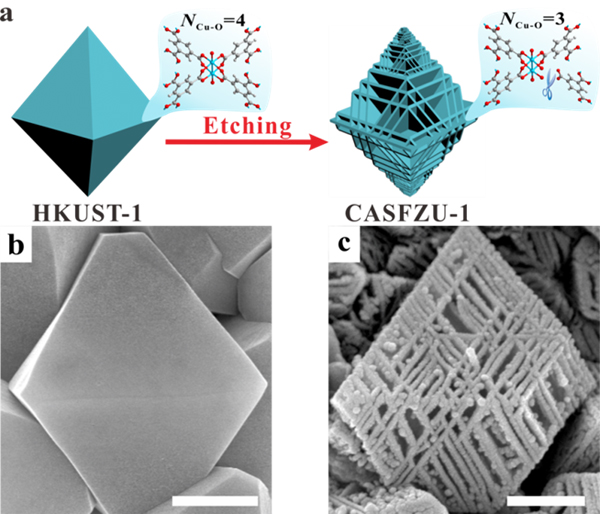Pyramid-like metal–organic frameworks promote CO2 chemical conversion
Engineering the coordination mode of atom or ion onto the substrate remains challenging. Here, guided by theoretical calculation, the team reported their success in preparing stacked-nanosheet metal–organic frameworks (MOFs-CASFZU-1) based catalyst with precisely controlled coordination sites on the surface and enhanced catalytic reactivity and structural robustness.
Monodispersed single atoms and ions on solid substrates, as unsaturated coordinated metal sites, have exhibited excellent catalytic activity. However, it is rarely reported in systematically tuning coordination modes and establishing the exact structure-to-property correlation in coordinatively unsaturated metal atoms for catalysis.
Recently, Professor Wang and colleagues took inspiration from the hexagonal-shaped cells of a honeycomb, which provide relatively high out-of-plane compression and shear properties, and develop an etching strategy for preparation of CASFZU-1 with three-coordinated copper (Cu) by selectively etching the classical MOF-HKUST-1 along the (111) facets. The highly active three-coordinated Cu sites were effective for important cycloaddition reaction of CO2, inducing activity markedly exceeding the maximum values of previous reported catalysts, especially under industrially favoured conditions of non-energy consumption. The CASFZU-1 heterogeneous catalyst could maintain undiminished activity in marked contrast to the nanosheet catalyst that typically suffers from fragmentation and aggregation to form large unreactive species that prevent continuity of the reaction. This study could form a basis for the rational design and construction of highly efficient and robust catalysts in the field of single-atom or ion catalysis.
The research team includes a group led by Dr. WANG Tie from the Institute of Chemistry, CAS, and a group led by LIN Zhenyu from Fuzhou University. HUANG Chuanhui, DONG Juncai and SUN Weiming made major contributions to this work. The research was supported by China “National Natural Science Foundation”, “National Key Research and Development Program”, the Chinese Academy of Sciences and et al.
Their work entitled “Coordination mode engineering in stacked-nanosheet metal–organic frameworks to enhance catalytic reactivity and structural robustness” has been published in Nature Communications 2019, 10, 2779.

Illustration of etching strategy for preparation of CASFZU-1. (Image by Dr. HUANG Chuanhui)
Contact:
Prof. WANG Tie
Institute of Chemistry, Chinese Academy of Sciences
Tel: +86-10-82362042
E-mail: wangtie@iccas.ac.cn





